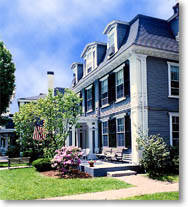 |
|
|
 |
|||
|
Prior to 1663:
The land
was owned by Peter Bulkeley, one of the original settlers 1663: Land
sold by Peter Bulkeley's widow, Grace, to Captain Timothy Wheeler 1687: Captain
Wheeler left his land to his daughter Rebecca, wife of Captain James Minot,
(J. Minot, 1653-1735). Late 1600's: James
Minot built the East House: exact date not known. He was living in it
on November 14, 1716 1716: Captain
Minot deeded this East House to his son James. 1759: James,
Jr died, left "dwelling house, barns and all of the other buildings
on the home lot to my son Ephraim." 1766: Dr.
Minot mortgaged the property to another cousin, Samuel Minot, goldsmith,
Boston. 1770: Mortgage
discharged 1770-1775: Around
this time, during the Minot ownership, the Central Building was erected,
at west end of East House. It was described by townspeople as of one story,
heavily timbered; it was used as a Provincial storehouse during the Revolution. 1780: Deacon
John White hired the new building for a store, and lived in one end of
it. He soon added a second story and moved upstairs. The store specialized
in paints and oils, but also carried general merchandise; the sign said
VARIETY
STORE. 1789: Timothy
Minot sold the East House to Ammi White, the cabinet maker, who, as a
boy, was the one who killed the third British solder at the Bridge with
an axe. He was the son-in-law of Dr. Minot, and added a long shop, or
shed, to his East House. On this same day, Dr. Minot sold the Central
Building to Deacon White. 1799: Oct. 30.
Ammi White
sold his East House to John Thoreau (1754-1801) of 1801: Thoreau
died, his widow and children, including 14 year old John, continued residence
in the East House with John Sr.'s two sisters, Sarah, a town seamstress,
and Elizabeth (Betsy), who inherited the house. The boy John (1788-1859)
worked as a clerk in the store for awhile. He became Henry David Thoreau's
father. 1812: The
Central Building, or store, passed from Deacon White to Merrs. Hemmenway
and Shattuck, but White retained an interest in the store. 1820: About
this date, Deacon White built a duplicate section at the west end of the
store for his own house. It was his task to stop people from traveling
on Sunday and he was especially strict about Lowell Rd. 1821: Daniel
Shattuck, partner of Deacon White, who had been living over the store,
bought the store and stock from White. 1835-1837: Henry
David Thoreau, his parents, sisters and brothers lived in West House with
aunts Betsy and Sarah: Henry was a student at Harvard. 1839: Betsy
Thoreau died. Dan Shattuck bought the East House. Eventually it was occupied
by R.N. Rice, Mrs. Barlow, the Tolmans, Simonds, and many other tenants
until 1885. Rueben Rice was manager of the Green Store, where the Catholic
Church now stands, and then he went west to work for the railroads; he
returned to Concord as a town financial benefactor. F.S. Simonds was the
author of several history books. 1850: Shattuck
made over the whole store building into a dwelling, which he rented to
1855: The
Central building became a boarding house. Soon this building was attached
to East House and the combination was run as a small hotel called Thoreau
House. It was run by several people, including Thatcher Magoun, W.E. Rand,
and J. Tarleton. 1861: Dan
Shattuck was still living in West House, but with his daughter Frances
who was married to Louis A. Surette, Jr.; he deeded her this property
and East House. Thomas Surette, the son, became a famous musician. 1865: East
House owned by trustees of the town donations and run as a boarding house. 1900: About
this time West House was attached to the Central Building; it was managed
by Mr. and Mrs. Abrams, who gave the entire structure its present name,
Colonial Inn. 1947: Ownership
of the Inn taken over by the Grimes brothers, Luther and Loring. For
17 years Loring was resident director, and added the Prescott wing in
1960 and the dining
room in 1973. 1988:
When hotelier
Jurgen Demisch became proprietor in 1988, he soon recognized that he had
become caretaker to a landmark that is often a visitor's first introduction
to Concord. Major renovations and redecoration of the Inn took place with
wife Rebecca, and patrons responded to the high standards for food and
service. 
|
|||
|
©2000-2026
copyright Concord Colonial Inn, All Rights Reserved Site Design by Web Design resources |
|||